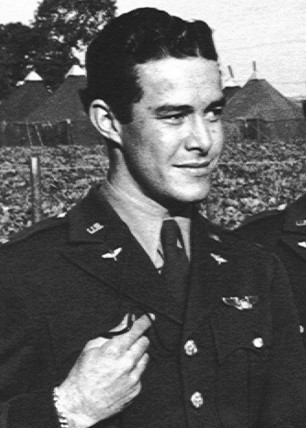Federico Gonzales, PhD, 1921-2007
By Emma Florio, Special Collections Library Assistant
Federico “Fred” Gonzales was born on July 16, 1921, in San Antonio, Texas, to Mexican parents. Gonzales dreamed of being a pilot. Once the United States entered World War II, he put his college education on hold and joined the United States Army Air Forces, the predecessor of the US Air Force. He wanted to be a fighter pilot but the Army needed bomber pilots; he would have to fly 25 missions in a bomber before he could pilot a jet fighter.
%20(from%20Am%20Air%20Museum%20in%20Britain).jpeg) |
|
Gonzales in uniform during the war, from the American Air Museum in Britain.
|
On January 23, 1945, Gonzales, now a 1st Lieutenant, was piloting a B-17 bomber during a raid on Düsseldorf, Germany, on his 25th and final mission. The plane was shot down over the neighboring city of Neuss and Gonzales and the rest of the 10-man crew fell 27,000 feet (over 5 miles) to the ground. Gonzales was the sole survivor of the crash despite breaking most of his bones, though not his skull or his spine, which may have saved his life. He was in a German hospital for almost 3 months before being liberated by American forces. He then returned to San Antonio to begin the long process of recovery.
Two months after returning home, Gonzales married Anna Mosher, a teacher he had met before the war; they would go on to have seven sons. Due to his injuries Gonzales had to abandon his dreams of being a pilot. He turned his interests to biology and three years later he received his BS in the subject from St. Mary’s University in San Antonio. He then attended St. Louis University where he earned his MS in biology in 1951 and his PhD in biophysics in 1953.
Gonzales began his early professional career conducting research and teaching anatomy at both the University of Texas and Baylor University. In 1959 he spent a year as a Research Associate at Harvard School of Dental Medicine, studying the ultrastructure of hard tissues with an electron microscope, an instrument that would become central to his career.
In 1963 Gonzales became an Associate Professor of Anatomy at Northwestern University Medical School, where he spent the next 23 years of his career. He taught courses on microscopic anatomy for medical and dental students and would begin his lectures by addressing his class as “Fellow students.” A colleague at Northwestern noted his artistic ability and said that his strong visual sense allowed him to explain complex matters in a comprehensible fashion. He also distinguished himself as a pioneer in the field of cryo-methods for electron microscopy and developed histological techniques for the electron microscope.
 |
|
Gonzales later in life with a flight jacket, via Legacy.com.
|
Gonzales retired in 1986. In 1988, 43 years after leaving the military, he learned that he had received a Distinguished Flying Cross during the war and had been promoted to Captain. His commanding officer had put in the papers, but they had been lost and Gonzales had been presumed dead after his plane crash, so the honors were forgotten. The special ceremony to present these honors made international news. He also returned to Neuss, Germany in 1988 and met with people who remembered his plane falling out of the sky.
Gonzales lived in Evanston for another 20 years, using his own darkroom and kiln to practice his hobbies of photography and pottery. He died at Evanston Hospital on February 8, 2007. He requested that his body be donated to the Feinberg School of Medicine so that, in his son Laurence’s words, he would come full circle.
Selected References
Jensen, Trevor. “Biophysicist, eternal optimist: Northwestern University medical school professor's WW II crash shattered most of his bones but couldn't scratch his upbeat spirit.” Chicago Tribune, February 12, 2007.
Updated: October 10, 2023